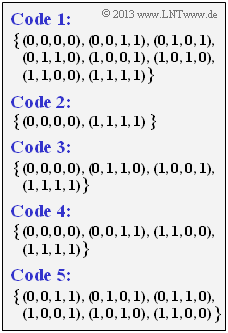Exercise 1.07Z: Classification of Block Codes
From LNTwww
Wir betrachten Blockcodes der Länge $n = 4$:
- den Single Parity–check Code $\text{SPC (4, 3)}$ ⇒ „Code 1” mit der Generatormatrix
- $${ \boldsymbol{\rm G}} = \begin{pmatrix} 1 &0 &0 &1\\ 0 &1 &0 &1\\ 0 &0 &1 &1 \end{pmatrix} \hspace{0.05cm},$$
- den Wiederholungscode $\text{RC (4, 1)}$ ⇒ „Code 2” mit der Prüfmatrix
- $${ \boldsymbol{\rm H}} = \begin{pmatrix} 1 &0 &0 &1\\ 0 &1 &0 &1\\ 0 &0 &1 &1 \end{pmatrix} \hspace{0.05cm},$$
- den $\text{(4, 2)}$–Blockcode ⇒ „Code 3” mit der Generatormatrix
- $${ \boldsymbol{\rm G}} = \begin{pmatrix} 1 &0 &0 &1\\ 0 &1 &1 &1 \end{pmatrix} \hspace{0.05cm},$$
- den $\text{(4, 2)}$–Blockcode ⇒ „Code 4” mit der Generatormatrix
- $${ \boldsymbol{\rm G}} = \begin{pmatrix} 1 &1 &0 &0\\ 0 &0 &1 &1 \end{pmatrix} \hspace{0.05cm},$$
- einen weiteren „Code 5” mit dem Codeumfang $|\hspace{0.05cm}C\hspace{0.05cm}| = 6$.
In der Grafik sind die einzelnen Codes explizit angegegeben. Bei den Fragen zu diesen Aufgaben geht es um die Begriffe
Hinweise :
- Die Aufgabe gehört zum Kapitel Allgemeine Beschreibung linearer Blockcodes.
- Bezug genommen wird aber auchauf die Seiten Single Parity–check Codes sowie Wiederholungscodes.
Fragebogen
Musterlösung
(1) Richtig sind die Aussagen 1 und 2:
- Deshalb gibt es auch $\rm 4 \ über \ 2 = 6$ Codeworte.
- Aussage 3 ist falsch. Ist zum Beispiel das erste Bit $0$, so gibt es ein Codewort mit dem Beginn $00$ und zwei Codeworte, die mit $01$ beginnen.
(2) Richtig sind die Aussagen 1 bis 4:
- Alle Codes, die durch eine Generatormatrix $\boldsymbol {\rm G}$ und/oder eine Prüfmatrix $\boldsymbol {\rm H}$ beschrieben werden können, sind linear.
- Dagegen erfüllt „Code 5” keine der für lineare Codes erforderlichen Bedingungen. Beispielsweise
- fehlt das Nullwort,
- ist der Codeumfang $|\mathcal{C}|$ keine Zweierpotenz,
- ergibt $(0, 1, 0, 1) \oplus (1, 0, 1, 0) = (1, 1, 1, 1)$ kein gültiges Codewort.
(3) Richtig sind die Aussagen 1 bis 3:
- Bei einem systematischen Code müssen stets die ersten $k$ Bit eines jeden Codewortes $\underline{x}$ gleich dem Informationswort $\underline{u}$ sein.
- Dies wird erreicht, wenn der Beginn der Generatormatrix $\boldsymbol {\rm G}$ eine Einheitsmatrix $\boldsymbol{\rm I}_{k}$ darstellt.
- Dies trifft für „Code 1” (mit Dimension $k = 3$), „Code 2” (mit $k = 1$) und „Code 3” (mit $k = 2$) zu.
- Die Generatormatrix von „Code 2” ist allerdings nicht explizit angegeben. Sie lautet:
- $${ \boldsymbol{\rm G}} = \begin{pmatrix} 1 &1 &1 &1 \end{pmatrix} \hspace{0.05cm}.$$
(4) Richtig ist die Aussage 1:
- Von dualen Codes spricht man, wenn die Prüfmatrix $\boldsymbol {\rm H}$ des einen Codes gleich der Generatormatrix $\boldsymbol {\rm G}$ des anderen Codes ist.
- Dies trifft zum Beispiel für „Code 1” und „Code 2” zu.
- Für den SPC (4, 3) gilt:
- $${ \boldsymbol{\rm H}} = \begin{pmatrix} 1 &1 &1 &1 \end{pmatrix} \hspace{0.05cm}, \hspace{0.3cm} { \boldsymbol{\rm G}} = \begin{pmatrix} 1 &0 &0 &1\\ 0 &1 &0 &1\\ 0 &0 &1 &1 \end{pmatrix} \hspace{0.05cm},$$
- und für den Wiederholungscode RC (4, 1):
- $${ \boldsymbol{\rm G}} = \begin{pmatrix} 1 &1 &1 &1 \end{pmatrix} \hspace{0.05cm}, \hspace{0.3cm} { \boldsymbol{\rm H}} = \begin{pmatrix} 1 &0 &0 &1\\ 0 &1 &0 &1\\ 0 &0 &1 &1 \end{pmatrix} \hspace{0.05cm}.$$
- Aussage 2 ist mit Sicherheit falsch, schon aus Dimensionsgründen: Die Generatormatrix $\boldsymbol {\rm G}$ von „Code 3” ist eine $2×4$–Matrix und die Prüfmatrix $\boldsymbol {\rm H}$ von „Code 2” eine $3×4$–Matrix.
- „Code 3” und „Code 4” erfüllen ebenfalls nicht die Bedingungen dualer Codes. Die Prüfgleichungen von
- $${\rm Code}\hspace{0.15cm}3 = \{ (0, 0, 0, 0) \hspace{0.05cm},\hspace{0.1cm} (0, 1, 1, 0) \hspace{0.05cm},\hspace{0.1cm}(1, 0, 0, 1) \hspace{0.05cm},\hspace{0.1cm}(1, 1, 1, 1) \}$$
- lauten:
- $$x_1 \oplus x_4 = 0\hspace{0.05cm},\hspace{0.2cm}x_2 \oplus x_3 = 0 \hspace{0.3cm} \Rightarrow\hspace{0.3cm} { \boldsymbol{\rm H}} = \begin{pmatrix} 1 &0 &0 &1\\ 0 &1 &1 &0 \end{pmatrix} \hspace{0.05cm}.$$
- Dagegen ist die Generatormatrix von „Code 4” wie folgt gegeben:
- $${ \boldsymbol{\rm G}} = \begin{pmatrix} 1 &1 &0 &0\\ 0 &0 &1 &1 \end{pmatrix} \hspace{0.05cm}.$$
